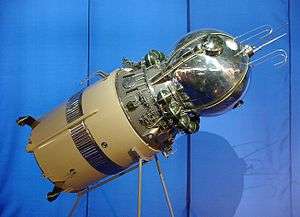Kosmos 57
Kosmos 57 (Russian: Космос 57 meaning Cosmos 57) was an unmanned Soviet spacecraft launched on 22 February 1965.[3] The craft was essentially an unmanned version of Voskhod 2. Its primary mission was to test the Volga airlock. The test was successful, but the craft was lost shortly after. The spaceflight is designated under the Kosmos system, placing it with many other Soviet scientific and military satellites.
| Mission type | Test flight Voskhod 2 spacecraft |
|---|---|
| Operator | OKB-1 |
| COSPAR ID | 1965-012A |
| SATCAT no. | 01093 |
| Mission duration | ≈ 3.5 hours |
| Spacecraft properties | |
| Spacecraft | Vostok-3KD No.1 |
| Manufacturer | OKB-1 |
| Launch mass | 5682 kg [1] |
| Start of mission | |
| Launch date | 22 February 1965, 07:41:00 GMT |
| Rocket | Voskhod 11A57 s/n R15000-03 |
| Launch site | Baikonur, Site 31 |
| Contractor | OKB-1 |
| End of mission | |
| Disposal | Self-destructed |
| Destroyed | 22 February 1965 |
| Decay date | 31 March — 6 April 1965 |
| Orbital parameters | |
| Reference system | Geocentric [2] |
| Regime | Low Earth |
| Perigee altitude | 165 km |
| Apogee altitude | 427 km |
| Inclination | 64.8° |
| Period | 91.1 minutes |
| Epoch | 22 February 1965 |
Mission
The unmanned craft was launched three weeks before Voskhod 2. The primary objective of Voskhod 2 was to conduct a spacewalk, which relied on the inflatable Volga airlock. Kosmos 57 was to test the performance of the airlock. The airlock opened and closed successfully and the craft was re-pressurized without flaw.[4]
Destruction
The unmanned spacecraft was destroyed on its third orbit around Earth. Two ground control stations, one in Klyuchi and the other in Yelizovo, sent simultaneous commands, instead of sequentially as planned, instructing the craft to depressurize its airlock. The craft interpreted this as an order to begin the descent and a propulsion error put the craft into a tumble. Approximately twenty-nine minutes later, the craft's automatic self-destruct function activated. The craft was completely destroyed to prevent sensitive information from literally falling into enemy hands. Over 100 pieces of the spacecraft were tracked, falling into the ocean between 31 March and 6 April 1965.[5] No other test or backup spacecraft was built with an EVA port. The decision was made to go ahead with Voskhod 2 anyway, due to a one-year lead time to construct a replacement. Planned follow-on Voskhod missions were cancelled, including the Soviet Air Force version, long-duration one-man flight.[6]
 Vostok spacecraft
Vostok spacecraft Voskhod 1 and Voskhod 2 spacecraft
Voskhod 1 and Voskhod 2 spacecraft Volga airlock and Berkut spacesuit like those used for the spacewalk of Alexey Leonov on the Voskhod 2 mission, Memorial Museum of Cosmonautics, Moscow.
Volga airlock and Berkut spacesuit like those used for the spacewalk of Alexey Leonov on the Voskhod 2 mission, Memorial Museum of Cosmonautics, Moscow.
See also
References
- https://nssdc.gsfc.nasa.gov/nmc/spacecraft/display.action?id=1965-012A - 27 February 2020
- https://nssdc.gsfc.nasa.gov/nmc/spacecraft/displayTrajectory.action?id=1965-012A - 27 February 2020
- Baker, David (1996). Spaceflight and Rocketry. United States of America: Facts on File Inc. pp. 176. ISBN 0-8160-1853-7.
- Evans, Ben (2009). Escaping the Bonds of Earth. Chichester, UK: Praxis Publishing. p. 196. ISBN 978-0-387-79093-0.
- Hall, Rex; Shayler, David (2001). The Rocket Men, Vostok and Voskhod, the First Soviet Manned Spaceflights. Chichester, UK: Praxis Publishing. p. 243. ISBN 1-85233-391-X.
- https://nssdc.gsfc.nasa.gov/nmc/spacecraft/display.action?id=1965-012A - 27 February 2020